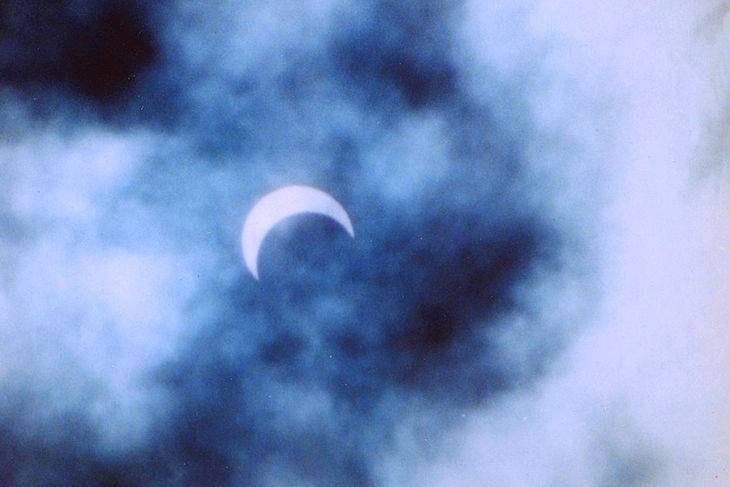Interested in Photographing the Solar Eclipse? Read On!

On August 21, 2017, there will be a total solar eclipse visible in a 70-mile wide belt spanning all across the US. This will be the first total solar eclipse visible from anywhere on mainland United States since the total solar eclipse in March 1979. The next one will be in April 2024, but it will not be visible from nearly as many US locations as the 2017 eclipse.
The eclipse shadow makes landfall in Oregon and begins its exceedingly quick trip across the country. According to timeanddate.com, in the Washington DC area, it will start at 1:17 pm, be at its maximum at 2:42 pm, and will end at 4:01 pm (all times are EST). Unfortunately, the totality phase of this solar eclipse is not visible in the DC area as we are too far north; we will only see a partial solar eclipse, where the Moon covers a large portion of the Sun. If you want to see the total eclipse on the east coast, you will have to go to South Carolina. You can also see it in Paducah, Kentucky and Nashville, Tennessee. Where ever you are able to see it, It is a spectacular sight!
What is a Solar Eclipse?
A solar eclipse happens when the New Moon moves between the Sun and Earth, blocking out the Sun’s rays and casting a shadow on parts of Earth. For a solar eclipse to take place, the Sun, the Moon, and Earth must be aligned in a perfect or near perfect straight line–an alignment astronomers call syzygy.
The Moon’s shadow is not big enough to engulf the all of the earth, so the shadow is always limited to a certain area. This area changes during the course of the eclipse because the Moon and Earth are in constant motion: Earth continuously rotates around its axis while it orbits the Sun, and the Moon orbits Earth.
There are between 2 and 5 solar eclipses every year, each one visible only in a limited area. Even though solar eclipses take place every year, they are considered a rare sight, much rarer than a lunar eclipse. There are 2 reasons for this:
- A solar eclipse is only visible from a limited path on Earth, while a lunar eclipse is visible from every location on the night-side of the Earth while it lasts.
- Lunar eclipses also tend to last longer than solar eclipses and therefore occur much more frequently in any given location.
Some words of warning:
NEVER look directly at the Sun, eclipsed or otherwise, without any protective eyewear. The Sun’s UV radiation can burn the retinas in your eyes leading to permanent damage or even blindness. The best way to safely watch a total solar eclipse is to wear protective eclipse glasses or to project an image of the eclipsed Sun using a pinhole projector.
Also protect your gear – Pointing your camera directly at the sun can damage the optics, sensor, and more. If you are photographing the eclipse, DO NOT look at the sun through an unfiltered lens or a camera’s optical viewfinder. Also, DO NOT point an unfiltered digital camera or lens at the sun to view the sun through the digital viewfinder or LCD screen. You may damage the equipment’s delicate sensors.
Still Interested in photographing the Solar Eclipse on August 21?
You can easily shoot the sun hand-held through a solar viewing filter. Your shutter speeds will be very quick as the sun is very bright, even when viewed through a solar filter. But, for prolonged photography, a tripod should be at the top of your list.
A tripod is recommended for prolonged observation and photography of the sun in order to reduce fatigue and maximize image sharpness, especially during the relative darkness of totality during the eclipse. When shooting from a tripod, a remote shutter release—electronic, wireless, or threaded—will help maximize image sharpness and reduce camera shake.
Recommended Gear:
- Solar Filter: When photographing the sun, you will need a solar filter for your camera and lens. The ONLY time the filter is not needed is when the sun is completely obscured by the moon during the totality portion of a total solar eclipse. (The general consensus is not to use Neutral Density filters – they do not protect your eyes or your gear from non-visible IR and UV radiation like a Solar filter does!)
- Lens Mounting Filters: You can place a certified solar viewing filter in FRONT of your camera lens. Screw-in solar filters come in different sizes. If your lens opening is smaller, you can use step-up rings to accommodate a larger filter. Also, you can simply wrap a one-size-fits-all Mylar solar filter film sheet around the front of your lens. Metal-coated glass and black polymer filters will allow the sun to appear yellow or orange. Mylar filters will make the sun look white or blueish.
- Camera Mounting Filters: You can use a solar viewing filter that mounts between your camera and lens like the DayStar Camera Quark filters. These are highly-specialized filters that are designed for serious solar observing and are designed to filter out different wavelengths of light for the study of different aspects of the solar surface. These filters are designed for specific camera mounts like Nikon and Canon.
2. A tripod and remote shutter release
3. Lenses:
- If you’re interested in photographing just the sun and moon discs, then you will need to use a long lens (1000mm and longer on a full-frame sensor; 500mm or longer on a cropped sensor) to fill the frame. (Tip: Make sure the framing is not so tight that you crop the corona during the totality of the eclipse.)
- If you are interested in including some foreground scenery (like the Washington Monument?), use a wide-angle lens, but keep in mind that the sun will be very small in the frame.
4. Extra battery
5. .Extra Memory cards.
How To Set Up Your Camera
- Use a tripod for sharpness and to prevent fatigue during the eclipse.
- Mount your approved solar photography filter.
- Set your camera to the native ISO (the lowest un-boosted ISO setting) and adjust aperture and shutter speed as needed.
- As totality begins, remove your solar filter and photograph the eclipsed sun and corona-bracketing your exposures as needed. (This is the only time during the eclipse that you should remove the Solar filter.) Even though it will be dark, do not use a flash! It will only annoy those nearby who are watching the eclipse and won’t do anything to improve your image.
- Replace the solar filter at the end of totality and continue shooting, adjusting the aperture and shutter speed as needed.
Additional Recommendations:
Scout out possible locations and practice your solar photography before the eclipse occurs!
A more detailed/technical article is available here:
https://www.bhphotovideo.com/c/solar-observing/ci/33818/N/3583558376/sba#articles-reviews
